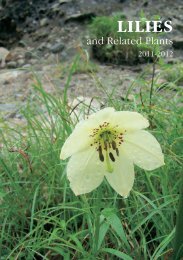LILIES - RHS Lily Group
LILIES - RHS Lily Group
LILIES - RHS Lily Group
You also want an ePaper? Increase the reach of your titles
YUMPU automatically turns print PDFs into web optimized ePapers that Google loves.
forested area that was heavily carpeted with moss, which was obviously subject to<br />
regular rainfall. When compared with the rock-hard soil conditions we had found<br />
L. kelloggii growing in near Onion Lake, this suggests a lily that is more tolerant of<br />
the vicissitudes of rainfall (more or less) than the reference books indicate. The<br />
other interesting aspect about L. kelloggii was the variation in flower colour, from<br />
very pale to a deep rose pink (similar in colour to L. wardii). When the yellow<br />
variant (mentioned earlier) is added to this range, it’s a wonder the “splitters”<br />
have accepted that these variations are all expressions of the one species. By<br />
the time we drove back to the coast and headed north past Trinidad (a pleasant,<br />
vaguely neo-hippy town) the Scottish weather had become more appropriately<br />
Californian, i.e. the sun was shining, and we encountered our last roadside lily,<br />
L. columbianum. As time was pressing, we had a limited opportunity to appreciate<br />
this pretty, slightly recurved orange lily before we had to head south to Sacramento.<br />
Up with the lark (or its American equivalent), the last day of the lily chase found<br />
us heading north-east to our starting point, Reno. En-route we visited a graveyard<br />
in a place called Georgetown in the hope of seeing L. humboldtii in flower, but<br />
unfortunately the flowers had past. But I did think what a splendid lily to have<br />
growing on your grave – none better perhaps. Our luck seemed to be leaving<br />
us when we thought we had missed all of the L. parvum in flower in a ditch area<br />
that had once been a guaranteed source for this species. However, we did find<br />
one stem with a few flowers of a lilac pink colour, which was immeasurably better<br />
than nothing. As we didn’t have sufficient time to search for plants of L. parvum<br />
var. hallidayi, Barb decided we should re-visit the stands of L. pardalinum we<br />
had admired on the first full day of the lily chase. It would seem that she must<br />
have had a premonition of something special in making this suggestion, because<br />
among the, probably, hundreds of orange flowered plants growing on both sides<br />
of the road there were a few (five or six) plants that were sporting yellow flowers.<br />
The question is why? Another question is how do the yellow flowered lilies<br />
maintain their colour-integrity when this must surely be under threat through<br />
cross-hybridisation from the army of their orange relatives that surround them?<br />
Unfortunately, I neglected to suggest to Barb that she should, at a later date, collect<br />
seed from the yellow flowered L. pardalinum plants, as it would be interesting<br />
to discover whether the seedlings produced yellow flowers, exclusively, or some<br />
yellow and some orange as does L henryi var. citrinum. Discussing this interesting<br />
find kept us fully occupied until we reached Reno and the end of our six-day,<br />
1500 plus mile lily chase, during which we found ten species and some interesting<br />
hybrids in perfect flowering condition.<br />
In retrospect, and as a seasoned (or old if you prefer) hill-walker, i.e. someone<br />
who is used to parking his car, walking to his objective, climbing it and then<br />
walking back to his car, I found the modus operandi of most of the lily-chase<br />
78




